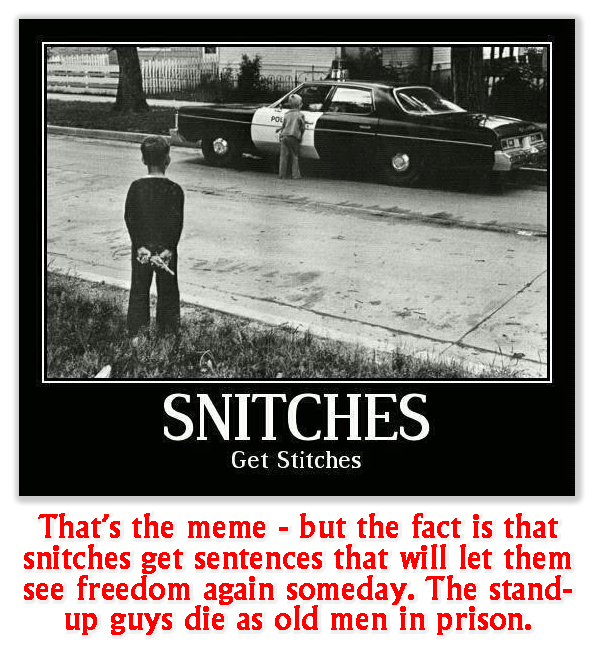We post news and comment on federal criminal justice issues, focused primarily on trial and post-conviction matters, legislative initiatives, and sentencing issues.
THEY’RE BA-A-A-A-CK
 A substantial percentage of defendants who get sentenced every year in the federal system cooperate with the government. Rats, snitches, narcs, whatever you call it, cooperating with the authorities is most of the time nothing more than an exercise in self-preservation. The US criminal code has so many offenses carrying harsh and inflexible mandatory minimum sentences, and the advisory Sentencing Guidelines (which are followed by judges about half of the time) can be unforgiving. The only way a defendant can escape application of a mandatory minimum sentence is through cooperation with the government.
A substantial percentage of defendants who get sentenced every year in the federal system cooperate with the government. Rats, snitches, narcs, whatever you call it, cooperating with the authorities is most of the time nothing more than an exercise in self-preservation. The US criminal code has so many offenses carrying harsh and inflexible mandatory minimum sentences, and the advisory Sentencing Guidelines (which are followed by judges about half of the time) can be unforgiving. The only way a defendant can escape application of a mandatory minimum sentence is through cooperation with the government.
If the United States Attorney’s Office files a motion for a downward departure under 18 USC 3553(e) and Sec. 5K1.1 of the Guidelines, a sentencing judge may sentence without regard for mandatory minimum sentences or the advisory Guidelines. Consider a defendant charged with two drug transactions on successive days, at each of which he sold 6 grams of methamphetamine (about the weight of a sugar cube) while carrying a gun. He has a prior state conviction for drug dealing, too, although the conviction is 25 years old. Under 21 USC 841(b), he faced a statutory minimum of 10 years for the drugs, a consecutive 5 years for carrying the gun during the first sale, and another consecutive 25 years for carrying the gun the second day. Under the law, the sentencing judge would have to lock up the miscreant for 40 years (and in the federal system, he would have to serve 87% of that sentence, even if he behaved).
 But the government wants the guy who put you on the street corner. So it offers to drop one of the 18 USC 924(c) gun charges and not file the required not
But the government wants the guy who put you on the street corner. So it offers to drop one of the 18 USC 924(c) gun charges and not file the required not
ice to force the court to consider your 25-year old prior conviction. This cuts your minimum sentence from 40 years to 10 years. On top of that, the government offers to consider a 5K1.1 motion. All you have to do is cooperate.
Do you do the stand-up thing? Of course, if you’ve always admired the kamikazes. Otherwise, you cooperate. At sentencing, the government files the 5K1.1, recommending a 30% reduction from your statutory minimum 120 months. The court agrees, and you get a sentence of 87 months. Not a bad outcome for having started at 480 months.
It’s little wonder that 30% of defendants facing a drug mandatory minimum sentence get credit for cooperation. More would if the government offered it to them. But there is a dark side (at least if you, the defendant, are willing to so quickly forget the 40 years you faced without the deal). Inmates who got 5K1.1 downward departures in their sentences that took them below their statutory minimums have been the red-headed stepchildren of the Sentencing Commission’s 2-level reductions.
 In our above illustration, the defendant’s advisory Guidelines sentencing range – not considering the statutory mandatory minimum of 480 months – was 18-24 months. The plea agreement our defendant signed contained the usual boilerplate saying the district court would consider applicable guideline provisions, but everyone knew that the statutory minimum of 10 years was what was driving the train, not the advisory Guidelines.
In our above illustration, the defendant’s advisory Guidelines sentencing range – not considering the statutory mandatory minimum of 480 months – was 18-24 months. The plea agreement our defendant signed contained the usual boilerplate saying the district court would consider applicable guideline provisions, but everyone knew that the statutory minimum of 10 years was what was driving the train, not the advisory Guidelines.
Three times in the last decade, the Sentencing Commission has reduced the base offense levels applicable to drugs by 2-levels per step. The last one was in 2014, at which time 31,089 already-convicted people won retroactive sentence reductions. But when our defendant in the example subsequently applies for the 2-level reduction, the government argues that he expressly acknowledged in his plea that the crime was subject to a mandatory minimum sentence. Thus, the government says, the sentence was based on a statutory minimum, not a guideline and not on “a sentencing range… lowered by the Sentencing Commission” (which is required for a sentence reduction).
The Supreme Court last considered the “based on” language in 2011, and in Freeman v. United States, split 4-1-4, which left only confusion. It takes up the matter again tomorrow in two arguments, Koons v. United States and Hughes v. United States.
 In Koons, the justices will decide whether defendants subject to statutory mandatory minimum sentences, but who received prison terms below the minimum because they provided substantial assistance to the government, are nonetheless eligible for reductions under 18 U.S.C. §3582(c)(2). The petitioners, five guys who were denied the 2-level reduction approved by the USSC in Amendment 782, lost in front of the 8th Circuit, which declaring that each defendant had received a sentence “based on his statutory mandatory minimum sentence and his substantial assistance” and thus could not claim to have received a prison term “based on a sentencing range that has subsequently been lowered by the Sentencing Commission .”
In Koons, the justices will decide whether defendants subject to statutory mandatory minimum sentences, but who received prison terms below the minimum because they provided substantial assistance to the government, are nonetheless eligible for reductions under 18 U.S.C. §3582(c)(2). The petitioners, five guys who were denied the 2-level reduction approved by the USSC in Amendment 782, lost in front of the 8th Circuit, which declaring that each defendant had received a sentence “based on his statutory mandatory minimum sentence and his substantial assistance” and thus could not claim to have received a prison term “based on a sentencing range that has subsequently been lowered by the Sentencing Commission .”
The USSC issued a policy statement directing that defendants in this position are eligible for reductions, but the government does not care, arguing the Commission may not legally construe or define a sentence as being “based on” a guideline when it was not.
In Hughes v. United States, which will be argued first, the justices will consider the meaning of the 2011 4-1-4 split in Freeman. It is not a slam-dunk for either side in this case, but a favorable ruling – which will come in June – could open the door to 2-level reductions for a number of people who were previously not eligible.
Hughes v. United States, Case No. 17-155 (Supreme Court, oral argument Mar. 27, 2018)
Koons v. United States, Case No. 17-5716 (Supreme Court, oral argument Mar. 27, 2018)
– Thomas L. Root

